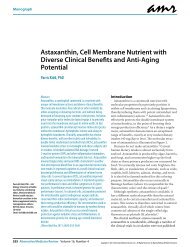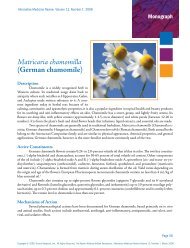Picrorhiza kurroa Monograph - Alternative Medicine Review
Picrorhiza kurroa Monograph - Alternative Medicine Review
Picrorhiza kurroa Monograph - Alternative Medicine Review
You also want an ePaper? Increase the reach of your titles
YUMPU automatically turns print PDFs into web optimized ePapers that Google loves.
animal studies indicate <strong>Picrorhiza</strong>’s constituents exhibit a strong anticholestatic activity against a varietyof liver-toxic substances, appearing to be even more potent than silymarin. <strong>Picrorhiza</strong> also exhibitsa dose-dependent choleretic activity, evidenced by an increase in bile salts and acids, and bile flow. 12Clinical IndicationsHepatic Insult and DamageNumerous animal studies, primarily in rats, have demonstrated that the active constituents of<strong>Picrorhiza</strong> <strong>kurroa</strong> are effective at preventing liver toxicity and the subsequent biochemical changescaused by numerous toxic agents. Hepatocytes damaged by exposure to galactosamine, thiocetamide,and carbon tetrachloride were incubated with <strong>Picrorhiza</strong> constituents. A concentration-dependent restorativeeffect was observed in regard to normal hepatocyte function. 13 A similar effect was seen when25 mg/kg/day oral <strong>Picrorhiza</strong> extract was administered to rats poisoned by aflatoxin B1 exposure.<strong>Picrorhiza</strong> <strong>kurroa</strong> significantly prevented the biochemical changes induced by aflatoxin B1. 14 <strong>Picrorhiza</strong>extract, when given at a dose of 3-12 mg/kg orally for 45 days, was also shown to be effective inreversing ethanol-induced liver damage in rats. 15 In an animal model of hepatic ischemia, rats given<strong>Picrorhiza</strong> orally at 12 mg/kg daily for 7 days, prior to induced ischemia, demonstrated improvedhepatocyte glycogen preservation and reduced apoptosis, compared to control animals. 16 <strong>Picrorhiza</strong>principals have also shown to be effective in treating Amanita mushroom poisoning in an in vivo animalmodel. 17 An in vitro study demonstrated <strong>Picrorhiza</strong>’s antioxidant activity by subjecting human Gliomaand Hep 3B cells to a hypoxic state. <strong>Picrorhiza</strong> treatment reduced the cellular damage cause by hypoxia,indicating <strong>Picrorhiza</strong> constituents may protect against hypoxia/reoxygenation-induced injuries. 18Viral HepatitisStudies indicate <strong>Picrorhiza</strong> extracts may be of therapeutic value in treating viral hepatitis. An invitro study investigated anti-hepatitis B-like activity of <strong>Picrorhiza</strong> and found it to have promising antihepatitisB surface antigen activity. 19 In a randomized, double-blind, placebo-controlled trial of 33patients diagnosed with acute viral hepatitis, 375 mg <strong>Picrorhiza</strong> root powder was given three timesdaily for two weeks. The treatment group was comprised of 15 patients; the remaining 18 subjectsacted as controls and received placebo. Bilirubin, SGOT, and SGPT values were significantly lower inthe treatment group, and the time required for bilirubin values to drop to 2.5 mg% was 27.4 days in thetreatment group versus 75.9 days for the placebo group. 20Asthma/AllergyIn vivo studies of bronchial obstruction indicate that the drosin constituent of <strong>Picrorhiza</strong> <strong>kurroa</strong>prevented allergen- and platelet activating factor-induced bronchial obstruction when given to guineapigs via inhalant and oral routes. In vitro histamine release was also inhibited by the plant extract. 21<strong>Picrorhiza</strong> extract given orally at 25 mg/kg to mice and rats resulted in a concentration-dependentdecrease in mast cell degranulation. However, induced bronchospasm was not prevented, indicating alack of direct post-synaptic histamine receptor blocking activity. 22Dosage and Toxicity<strong>Picrorhiza</strong> is not readily water-soluble and is therefore not usually taken as a tea. While it isethanol soluble, the bitter taste makes tinctures unpalatable, so it is therefore usually administered as astandardized (4% kutkin) encapsulated powder extract. Typical adult dosage is 400 to 1500 mg/day,with dosages up to 3.5 g/day sometimes being recommended for fevers. <strong>Picrorhiza</strong> root extracts arePage 320 <strong>Alternative</strong> <strong>Medicine</strong> <strong>Review</strong> ◆ Volume 6, Number 3 ◆ 2001Copyright©2001 Thorne Research, Inc. All Rights Reserved. No Reprint Without Written Permission







